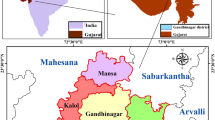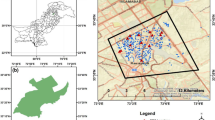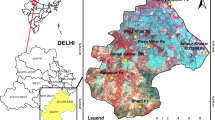Abstract
Land use and land cover modifications have been undergoing at a hasty pace across the world. The dynamics of growth and change in land use in Peshawar City during the period 1991–2014 was studied utilizing GIS and remote sensing technologies. Using Landsat TM imageries, this study examined land use alterations in urban and peri-urban Peshawar and their impact on ground water. Beside this, the study used temporal and spatial dataset of water table for the year 1991 and 2014 that were gathered from Water and Works Department Peshawar, Pakistan. This study also used Cellular Automata–Markov (CA–Markov model) to predict the future change in built up area up to 2044 on the basis of past trend (1991–2014) and its impact on the encroachment or loss of agricultural land as well as the level of ground water. The past trend of fluctuation of groundwater (in feet) with the expansion in size of built-uses was also used to predict future trend in ground water depletion. The most severe impact in terms of groundwater depletion will take place in the southern parts of the city. The sharp decrease of groundwater table was observed in the central parts of the city compared to the peripheries. If this declining trend of groundwater level continues that might put an amplified stress on underground aquifers and may trigger to land subsidence or other environmental hazards.




Source: Fig. 2: Peshawar city district: spatial changes in Land Use, 1991 and 2014; (A) Land use 1991, (B) Land use 2014. Horizontal Development of Built Up Area and Its Impacts on the Agricultural Land of Peshawar City District (1991–2014). Journal of the Indian Society of Remote Sensing (September 2019) 47(9):1537–1545.)




Similar content being viewed by others
References
Agam, N., Evett, S. R., Tolk, J. A., Kustas, W. P., Colaizzi, P. D., Alfieri, J. G., McKee, L. G., Copeland, K. S., Howell, T. A., & Chávez, J. L. (2012). Evaporative loss from irrigated interrows in a highly advective semi-arid agricultural area. Advances in Water Resources, 50, 20–30.
Ahmed, T., Shakeel, M., Khalid, S., & Ali, A. (2015). Change of agricultural land use in residential land and its impact on the socio-economic status of the farmer in Bahawalpur City. Asian Journal of Social Sciences & Humanities, 4, 3.
Al-Adamat, R. A. N., Foster, I. D. L., & Baban, S. M. J. (2003). Groundwater vulnerability and risk mapping for the basaltic aquifer of the Azraq Basin of Jordan using GIS, remote sensing and DRASTIC. Applied Geography, 23, 303–324.
Anderson, J. R., Hardy, E. E., Roach, J. T., & Witmer, R. E. (1976). A land use and land cover classification system for use with remote sensor data. US Government Printing Office.
Asadi, S. S., Vuppala, P., & Reddy, M. A. (2007). Remote sensing and GIS techniques for evaluation of groundwater quality in municipal corporation of Hyderabad (Zone-V), India. International Journal of Environmental Research and Public Health., 4(1), 45–52.
Bhalli, M., Ghaffar, A., & Shirazi, S. (2012). Remote sensing and GIS applications for monitoring and assessment of the urban sprawl in Faisalabad-Pakistan. Pakistan Journal of Science, 64(3), 203–208.
Breabăn, I. G., & Paiu, G. (2012). Application of drastic model and gis for evaluation of aquifer vulnerability: Study case Barlad City Area. In Water resources and wetlands conference proceedings, 1416 September. ISBN: 978–606–605–038–8.
Cao, H., Liu, J., Fu, C., Zhang, W., Wang, G., Yang, G., & Luo, L. (2017). Urban expansion and its impact on the land use pattern in Xishuangbanna since the reform and opening up of China. Remote Sens, 9, 137.
Collin, M. L., & Melloul, A. J. (2001). Combined land-use and environmental factors or sustainable groundwater management. Urban Water, 3, 229–237.
Congalton, R., & Green, K. (2009). Assessing the accuracy of remotely sensed data: Principles and practices (2nd ed.). Taylor and Francis Group.
Dams, J., Woldeamlak, S. T., & Batelaan, O. (2008). Predicting land-use change and its impact on the groundwater system of the KleineNete catchment, Belgium. Hydrology and Earth System Sciences, 12, 1369–1385.
Faqe, H. M., Hashemi, S. S. (2015). Impact of urban growth on groundwater levels using remote sensing-case study: Erbil City, Kurdistan Region of Iraq.
Foster, S., Hirata, R. &Garduno, H. (2010a). Urban groundwater use policy—balancing the benefits and risks in developing nations. GW-MATE strategic overview series 3. World Bank. Available at www.worldbank.org/gwmate.
Foster, S., &Cherlet, J. (2014). Global water partnership—the links between land use and groundwater. A GWP perspectives paper.
Foster, S. S. D., Morris, B. L., & Lawrence, A. R. (1993). Effects of urbanization on groundwater recharge. In W. B. Wilkinson (Ed.), Groundwater problems in urban areas (pp. 43–63). Proceeding of Institution of Civil Engineers.
Gautam, D. N., & Prajapati, R. (2014). Drawdown and dynamics of groundwater table in Kathmandu valley Nepal. The Open Hydrology Journal., 8(1), 17–26.
Geri, F., Amici, V., & Rocchini, D. (2010). Human activity impact on the heterogeneity of a mediterranean landscape. Applied Geography, 30(3), 370–379.
Gu, C., Hu, L., & Cook, I. G. (2017). China’s urbanization in 1949–2015: Processes and driving forces. Chinese Geographical Science, 27, 847–859.
Hansen, M. C., DeFries, R. S., Townshend, J. R. G., & Sohlberg, R. (2000). Global land cover classification at 1 km spatial resolution using a classification tree approach. International Journal of Remote Sensing, 21, 1331–1364.
Hassan, A. A., Rida, F., Telleria, R., & Bruggeman, A. (2014). The impact of food and agricultural policies on groundwater use in Syria. Journal of Hydrology, 513, 204–215.
Hayashi, T., Tokunaga, T., Aichi, M., Shimada, J., & Taniguchi, M. (2009). Effects of human activities and urbanization on groundwater environments: An example from the aquifer system of Tokyo and the surrounding area. Science of the Total Environment, 407(9), 3165–3172.
Huang, S., Wang, M., Wu, J., Li, Q., Yang, J., Guo, L., Wang, J., & Xu, Z. (2018). The exploration and practice on soilenvironmental protection in the process of rapid urbanization of the megacity Shanghai. In Y. Luo & C. Tu (Eds.), Twenty years research development on soil pollution remediation. Springer.
Jamal, T., Mazhar, F., & Kaukab, I. (2012). Spatio-temporal residential growth of Lahore city. Pakistan Journal of Science, 64(4), 293–295.
Kumar, S., & Sangwan, R. S. (2013). Urban growth, land use changes and its impact on cityscape in sonipat city using remote sensing and GIS techniques, Haryana, India. International Journal of Advanced Remote Sensing and GIS, 2(1), 326.
Li, L. (2009). The spatio-temporal dynamic characteristics in expansion of major cities in China in 30 years since the reform and opening-up. Journal of Natural Resources, 24, 223–226.
Liu, C., Frazier, P., & Kumar, L. (2007). Comparative assessment of the measures of thematic classification accuracy. Remote Sensing of Environment, 107, 606–616.
Manandhar, R., Odeh, I. O. A., & Ancev, T. (2009). Improving the accuracy of land use and land cover classification of landsat data using post-classification enhancement. Remote Sensing, 1, 330–344.
McDonald, R. I., Weber, K., Padowski, J., Flörke, M., Schneider, C., Green, P. A., & Montgomery, M. (2014). Water on an urban planet: Urbanization and the reach of urban water infrastructure. Global Environmental Change, 27, 96–105.
Mohammed, S. (2004). Urbanization and water resources vulnerability. In The Kumasi Metropolitan Area, Ghana. A master thesis submitted to the Department of Water and Environmental Studies at Linkoping University.
Mondal, N. C, Sankaran, S, & Singh V. P. (2011). Demarcation of prospective groundwater recharge zones in hard rock area from Southern India.
Morris, B. L., Lawrence, A. R., & Stuart, M. E. (1994). The impact of urbanization on groundwater quality (project summary report), Technical report WC/94/56, British Geological Survey.
Mukherjee, P., Singh, C. K., & Mukherjee, S. (2012). Delineation of groundwater potential zones in arid region of India—a remote sensing and GIS approach. Water Resources Management, 26, 2643–2672.
Mynt, S. W., & Wang, L. (2006). Multi criteria decision approach for land use land cover change using Markov chain analysis and a cellular automata approach. Remote Sensing, 32, 237–240.
Prakasam, C. (2010). Land use and land cover change detection through remote sensing approach: A case study of Kodaikanal Taluk Tamil Nadu. International Journal of Geomatic and Geosciences, 1, 150–158.
Putra, D., & Baier, K. (2008). Impact of urbanization on groundwater recharge–the example of the Indonesian million City Yogyakarta. In UN Habitat-United Nations Settlement Programs: Fourth session of the World Urban Forum, Nanjing, China, Documentations of Germany’s Contribution to a Sustainable Urban Future.
Putra, D., & Baier, K. (2008). Impact of urbanization on groundwater recharge the example of Indonesian million City Yogyakarta. In UN Habitat-United Nations Settlement Programme: Fourth session of the World Urban Forum, Nanjing, China, Documentations of Germany’s Contribution to a Sustainable Urban Future.
Rawat, J. S., Biswas, V., & Kumar, M. (2013). Changes in land use/land cover using geospatial techniques: A case study of Ramnagar town area, district Nainital Uttarakhand, India. The Egyptian Journal of Remote Sensing Space and Scirnce, 16, 111–117.
Ross, A., & Martinez-Santos, P. (2010). The challenge of groundwater governance: Case studies from Spain and Australia. Regional Environmental Change, 10(4), 299–310.
Serra, P., Pons, X., & Saurí, D. (2008). Land-cover and land-use change in a Mediterranean landscape: A spatial analysis of driving forces integrating biophysical and human factors. Applied Geography., 28(3), 189–209.
Shahid, S., Wang, X. J., Rahman, M. M., Hassan, R., Harun, S. B., & Shamsudin, S. (2015). Spatial assessment of groundwater over-exploitation in northwestern district of Bangladesh. Journal of the Geological Society of India, 85, 463–470.
Shrestha, M. K., York, A. M., Boone, C. G., & Zhang, S. (2012). Land fragmentation due to rapid urbanization in the Phoenix Metropolitan area: Analyzing the spatiotemporal patterns and drivers. Applied Geography, 32, 522–531.
Singh, L., Singh, H., & Singh, S. (2020). Managing natural resources and environmental challenges in the face of urban sprawl in Indian Himalayan City of Jammu. Journal of the Indian Society of Remote Sensing, 48(8), 1139–1147.
Song, X. (2017). Discussion on land use transition research framework. Acta Geographica Sinica, 72(3), 471–487.
Sonoda, K., Yeakley, J. A., & Walker, C. E. (2001). Near-stream land use effects on stream water nutrient distribution in an urbanizing watershed. Journal of the American Water Resources Association, 37, 1517–1532.
Surjan, A., Parvin, G. A., & Shaw, R. (2016). Impact of urban expansion on farmlands: A silent disaster. In Urban disasters and resilience in Asia (pp. 91–112). Butterworth-Heinemann.
Swenson, S., & Famiglietti, J. (2011). Sustainable groundwater management for large aquifers systems: Tracking depletion rates from space. Climate Change Effects on Groundwater Resources: A Global Synthesis of Findings and Recommendations, 367.
Tamilenthi, S., Punithavathi, J., Baskaran, R., & Chandra Mohan, K. (2011). Dynamics of urban sprawl. Changing Salem City, Tamilnadu India. Achieves of Applied Science Research, 3, 277–286.
Taubenböck, H., Wegmann, M., Roth, A., Mehl, H., & Dech, S. (2009). Urbanization in India-spatiotemporal analysis using remote sensing data. Computers Environment and Urban Systems, 33(3), 179–88.
Todd, D. K. (1963). Groundwater hydrology. J. Wiley & Sons.
Tu, J. (2013). Urban spatial expansion and its effect on island ecosystem. High Technology Letters, 19, 162–169.
Turner, B. L., Lambin, E. F., & Reenberg, A. (2008). The emergence of land change science for global environmental change and sustainability. Proceedings of the National Academy of Sciences, 104(52), 20666–20671.
Vahid, G. (2013). Modeling of ground water level using statistical method and GIS. A Case Study Amol–Babol Plain Iran, 2(3), 53–59.
Wang, W., Zhang, X., Wu, Y., Zhou, L., & Skitmore, M. (2017). Development priority zoning in China and its impact on urban growth management strategy. Cities, 62, 1–9.
Wang, Z., Tang, L., Qiu, Q., Chen, H., Wu, T., & Shao, G. (2018). Assessment of regional ecosystem health—a case study of the Golden Triangle of Southern Fujian Province, China. International Journal of Environmental Research and Public Health, 15, 802.
Weng, Q. A. (2001). Remote sensing-GIS evaluation of urban expansion and its impact on surface temperature in the Zhujiang Delta China. International Journal of Remote Sensing, 22, 1999–2014.
Wu, N., & Silva, E. (2010). Artificial/intelligence solutions for urban land dynamics: A review. Journal of Planning Literature, 24, 246–265.
Yar, P. (2020). Urban development and its impact on the depletion of groundwater aquifers in Mardan City Pakistan. Groundwater for Sustainable Development, 11, 100426.
Yar, P., & Huafu, J. (2019). Horizontal development of built-up area and its impacts on the agricultural land of Peshawar city district (1991–2014). Journal of the Indian Society of Remote Sensing, 47(9), 1537–1545.
Yi, X., Luo, G., & Weiguo, S. (2020). Impact of fast urbanization on ecosystem health in mountainous regions of Southwest China. International Journal of Environmental Research and Public Health, 17, 826.
Yuan, F., Sawaya, K. E., Loeffelholz, B. C., & Bauer, M. E. (2005). Land cover classification and change analysis of the Twin Cities (Minnesota) metropolitan area by multitemporal landsat remote sensing. Remote Sensing of Environment, 98, 317–328.
Zhang, X., Zhang, L., He, C., Li, J., Jiang, Y., & Ma, L. (2014). Quantifying the impacts of land use/land cover changeon groundwater depletion in Northwestern China—a case study of the Dunhuang oasis. Agricultural Water Management, 146, 270–279.
Zhang, Y. K., & Schilling, K. E. (2006). Effects of land cover on water table, soil moisture, evapotranspiration, and groundwater recharge: A field observation and analysis. Journal of Hydrology, 319, 328–338.
Author information
Authors and Affiliations
Corresponding author
Additional information
Publisher's Note
Springer Nature remains neutral with regard to jurisdictional claims in published maps and institutional affiliations.
About this article
Cite this article
Yar, P., Huafu, J., Khan, M.A. et al. Modification of Land Use/Land Cover and Its Impact on Groundwater in Peshawar City, Pakistan. J Indian Soc Remote Sens 50, 159–174 (2022). https://doi.org/10.1007/s12524-021-01464-w
Received:
Accepted:
Published:
Issue Date:
DOI: https://doi.org/10.1007/s12524-021-01464-w




